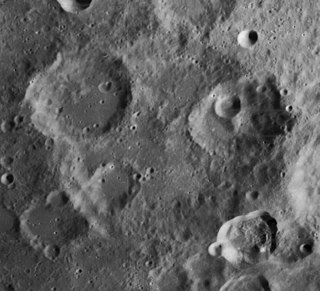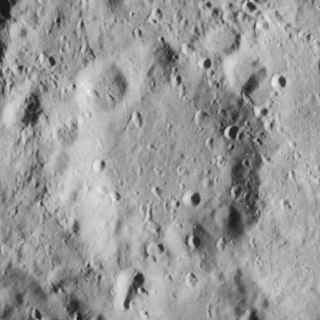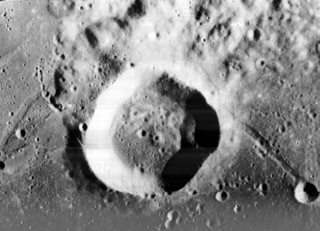
Archimedes is a large lunar impact crater on the eastern edges of the Mare Imbrium. Its diameter is 81 km.

Schickard is a lunar impact crater of the form called a walled plain. It lies in the southwest sector of the Moon, near the lunar limb. As a result, the crater appears oblong due to foreshortening. Attached to the northern rim is the lesser crater Lehmann, and to the northeast is the even smaller Drebbel. Southwest of Schickard is Wargentin, a lava-flooded plateau.

Hommel is a lunar impact crater located in the southeast section of the Moon, in a region that is deeply impacted with a multitude of impact craters. The most notable craters nearby are Pitiscus to the north; Rosenberger due east; and Nearch to the southeast. The prominent crater Vlacq is nearly attached to the northeast rim. Also nearby is Asclepi to the west. Hommel is about 120 kilometers in diameter and its walls reach heights of 2,800 meters. It is from the Pre-Nectarian period, 4.55 to 3.92 billion years ago.

Apianus is a lunar impact crater that is located on the rugged south-central highlands of the Moon. It is named after 16th century German mathematician and astronomer Petrus Apianus. It is located to the northeast of the crater Aliacensis, and to the northwest of Poisson. The worn crater Krusenstern is attached to the west-northwestern rim.

Donati is a lunar impact crater that is located in the rugged south-central highlands of the Moon. It lies just to the northwest of the crater Faye, and the two outer rims are separated by a gap of less than 10 kilometers. To the north is the comparably sized Airy, and farther to the southeast is Playfair. Donati is 36 kilometers in diameter.

Fabry is a large lunar impact crater of the form termed a walled plain. It is located on the far side of the Moon, just beyond the northeastern limb. Parts of this area are sometimes brought into view by the effects of libration, but the terrain is seen from the edge and so not much in the way of detail can be observed.

Deluc is a lunar impact crater that lies in the southern highlands of the Moon. It is located to the south-southeast of the crater Maginus, and the huge Clavius. Due east of Deluc is the somewhat larger crater Lilius. It is 47 kilometers in diameter and 3.3 kilometers deep. It is from the Pre-Imbrian period, which lasted from 4.55 to 3.85 billion years ago.

Curtius is a lunar impact crater that is located in the southern part of the Moon. From the Earth the crater appears foreshortened, making it more difficult to observe detail. Nevertheless, this is a large crater that can be readily found in even small telescopes. Curtius is located within one crater diameter of the still-larger Moretus to the southwest. To the northeast is the smaller Pentland. Curtius is 95 kilometers in diameter and 6.8 kilometers deep. It is from the Nectarian period, 3.92 to 3.85 billion years ago.

Darwin is a lunar impact crater of the type categorised as a walled plain. It lies in the southeastern part of the Moon, and is sufficiently close to the limb to appear significantly foreshortened when viewed from the Earth. Attached to its southern rim is Lamarck. To the northeast is the dark-floored crater Crüger.

Clairaut is a lunar impact crater that is located in the rugged southern highlands of the Moon's near side. It lies directly to the south of the crater Maurolycus and southeast of Barocius. Just to the southwest is Cuvier.

d'Alembert is a large lunar impact crater located in the northern hemisphere on the far side of the Moon, to the northeast of the somewhat smaller walled plain Campbell. Astride the southwest rim of d'Alembert is Slipher. To the north is the crater Yamamoto, and to the south-southwest lies Langevin. This walled plain has the same diameter as Clavius on the near side, making it one of the largest such formations on the Moon.

Schwarzschild is a large lunar impact crater, approximately 211 kilometers (131 mi) in diameter. It is located in the northern part of the Moon's far side. The nearest craters of note are Seares to the northeast, and Gamow to the southeast. It was named after German physicist and astronomer Karl Schwarzschild (1873–1916).

Dyson is a lunar impact crater, 63 kilometers in diameter, that lies on the far side of the Moon, past the northwest limb. It is located in the northern part of the surface, to the northwest of the crater Coulomb, and east of van't Hoff.

Wilkins is a lunar impact crater that lies in the rugged highlands in the southeastern part of the Moon's near side. It is located to the southwest of the crater Pons and the long Rupes Altai scarp. Just to the southeast lies the larger crater Zagut, and to the north-northwest is the still-larger Sacrobosco. Wilkins is 57 kilometers in diameter.

Hagecius is a lunar impact crater in the southeastern part of the Moon's near side. It was named after 16th century Czech naturalist Tadeáš Hájek. This crater forms a triangular formation with the craters Rosenberger to the north-northwest and Nearch to the west-northwest. Like both of these craters, Hagecius has undergone erosion from subsequent impacts, and its outer rim is worn and irregular. The southeastern rim in particular is overlaid by three smaller craters designated Hagecius C, B, and G.

Epimenides is a lunar impact crater that is located in the southwestern part of the Moon's near side, just to the east of the oddly shaped crater Hainzel. Just to the north and northeast is Lacus Timoris, a small lunar mare. The crater is 27 kilometers in diameter and 2,000 meters deep. It may be from the Pre-Nectarian period, 4.55 to 3.92 billion years ago.

Proctor is the remnant of a lunar impact crater that is located to the southeast of the prominent crater Tycho. It lies just to the north of the huge walled plain Maginus. To the north is the crater Saussure and to the northwest, just to the east of Tycho, lies Pictet. Proctor is 52 kilometers in diameter and its walls are 1,300 meters high. It is from the Pre-Imbrian period, which lasted from 4.55 to 3.85 billion years ago.

Kinau is a small, eroded lunar impact crater that is located in the low southern latitudes of the Moon. It lies to the southeast of the crater Jacobi, and about equally far to the north-northwest of Pentland. It is 42 kilometers in diameter and two kilometers deep. It may be from the Pre-Nectarian period, 4.55 to 3.85 billion years ago.

Rosenberger is an old lunar impact crater in the southeastern part of the Moon. It was named after German astronomer Otto August Rosenberger.

Pavlov is a lunar impact crater on the far side of the Moon, approximately 143 kilometers in diameter. Located just to the north-northeast of it is the crater Levi-Civita while to the southeast is Jules Verne.























